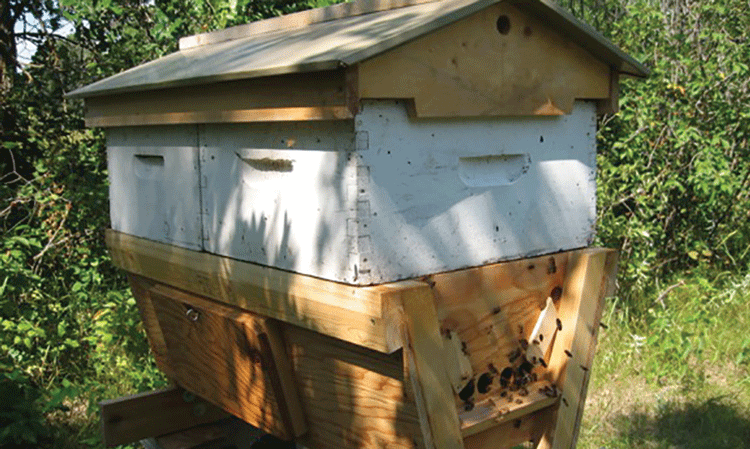By: David Dawson
If you’re going to manage your top bar hive for honey production – you’re going to have problems.
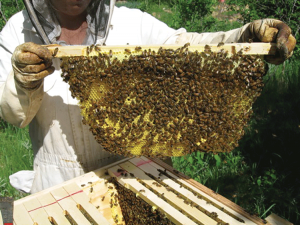 Introduction. Keeping bees has been my passion for close to 60 years partly as a hobbyist and partly as a small-scale commercial beekeeper. Although reluctantly at first, in 2014 a fellow beekeeper and I decided to experiment with keeping bees in a Top Bar Hive (TBH). We read a book on the subject from which I latched onto two possible positive features. These were, firstly, since the bees make all their own natural comb one does not use manufactured foundation that could include accumulated agricultural chemicals. And secondly, the natural cell size is 4.9mm as opposed to the 5.3mm commonly used by commercial foundation manufacturers. The 4.9mm cell size is said to shorten the time from egg to emergence by a few hours and also to hinder the development of Varroa mites. (This proved to be totally untrue, as you will read below). We decided to make a TBH so that we could test it out together.
Introduction. Keeping bees has been my passion for close to 60 years partly as a hobbyist and partly as a small-scale commercial beekeeper. Although reluctantly at first, in 2014 a fellow beekeeper and I decided to experiment with keeping bees in a Top Bar Hive (TBH). We read a book on the subject from which I latched onto two possible positive features. These were, firstly, since the bees make all their own natural comb one does not use manufactured foundation that could include accumulated agricultural chemicals. And secondly, the natural cell size is 4.9mm as opposed to the 5.3mm commonly used by commercial foundation manufacturers. The 4.9mm cell size is said to shorten the time from egg to emergence by a few hours and also to hinder the development of Varroa mites. (This proved to be totally untrue, as you will read below). We decided to make a TBH so that we could test it out together.
Design. In this prairie region of Canada honey crops of 200 pounds per hive is considered normal and 250 – 300 quite common. My own record was 516 pounds average so we deemed it necessary to allow for supers to be added. Many years ago I had a hive on a scale and weighed it every day after the bees had stopped flying in the evening. On one occasion the daily gain was 29 pounds with 106 pounds for the week.
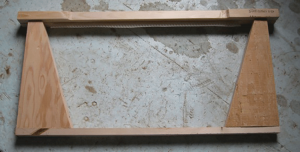 Unlike Langstroth hives there is no standard TBH size or design. You can find many different shapes and sizes on the internet/YouTube but none of those seemed to fit my ideas. Considering brood area, possible honey crops and many other factors I came up with what could be called a hybrid design. Essentially I made the length of the TBH to be the same as two Langstroth honey supers side-by side and the width to be the same as the length of a Langstroth super. Thus if we had a big honey flow (highly likely) two queen excluders and two supers would fit perfectly on top of the TBH. This necessitated making the top bars themselves narrower in the middle so the bees could get up into the supers. The narrow top bars then needed an inner cover under the roof, and a piece of canvas worked admirably.
Unlike Langstroth hives there is no standard TBH size or design. You can find many different shapes and sizes on the internet/YouTube but none of those seemed to fit my ideas. Considering brood area, possible honey crops and many other factors I came up with what could be called a hybrid design. Essentially I made the length of the TBH to be the same as two Langstroth honey supers side-by side and the width to be the same as the length of a Langstroth super. Thus if we had a big honey flow (highly likely) two queen excluders and two supers would fit perfectly on top of the TBH. This necessitated making the top bars themselves narrower in the middle so the bees could get up into the supers. The narrow top bars then needed an inner cover under the roof, and a piece of canvas worked admirably.
The sidewalls of the hive body itself were at 15 degrees (said to be more than adequate) and the depth of the hive calculated such that each TBH comb when drawn down was equivalent to one Langstroth brood comb. There was space for 21 bars as well as a half-bar at each end. The idea for the half-bar was that it could be easily removed to facilitate getting the first comb out. I made three entrances – one at each end and one in the middle. I also made two division boards so in theory it would be possible to have three separate colonies, each flying out of a separate entrance. And I made a vertical queen excluder.
“Checking for swarm cells is almost impossible.”
I decided to have short legs on the hive so that it could be lowered to the ground for easier protection during our cold Canadian winters, though in the end I modified a regular Langstroth hive body to fit the Top Bar combs and wintered them as a normal Langstroth hive. Temperatures in December and January can go down to minus 40 degrees so some kind of insulation is essential.
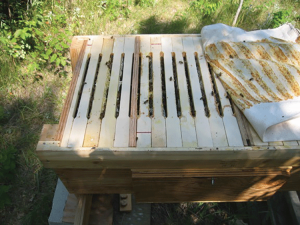 Installing the bees into the TBH was another problem. One option was an imported package but we had enough colonies already. Another option was to wait for a natural swarm, but again we were too impatient for that. So we opted for a ‘shook’ swarm. First I modified a couple of the top bars with some 15-degree pieces of wood that would fit into a regular Langstroth brood box. I attached strips of foundation made from my own old cappings wax and put them in the brood box of a regular hive. When these were drawn out and filled with brood, we removed the pieces of 15-degree wood and transferred the combs to the TBH. Then we shook in the rest of the bees in and closed up. Over the next few days, as they had lost all their stores, I gave them a gallon of syrup to encourage them to draw down new combs, which they did very well with lots of worker cells but also lots of drone cells.
Installing the bees into the TBH was another problem. One option was an imported package but we had enough colonies already. Another option was to wait for a natural swarm, but again we were too impatient for that. So we opted for a ‘shook’ swarm. First I modified a couple of the top bars with some 15-degree pieces of wood that would fit into a regular Langstroth brood box. I attached strips of foundation made from my own old cappings wax and put them in the brood box of a regular hive. When these were drawn out and filled with brood, we removed the pieces of 15-degree wood and transferred the combs to the TBH. Then we shook in the rest of the bees in and closed up. Over the next few days, as they had lost all their stores, I gave them a gallon of syrup to encourage them to draw down new combs, which they did very well with lots of worker cells but also lots of drone cells.
Manipulating. Inspecting the TBH is very difficult. One has to work from the side leaning over to pick up the other side of the top bar, and then it is only possible to look at one side. To look at the other side it was necessary to put the comb back in the hive and switch hands. You cannot turn the comb over – at least not with newly made wax and heavy with honey and brood.
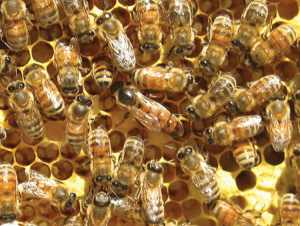 Checking for queen cells to stop them swarming was almost impossible because one cannot shake the bees off the combs to get a decent look. Even with two people checking, one on each side, we must have missed some queen cells because the colony swarmed. Common manipulations such as an artificial swarm or hiving the swarm on the parent stand seemed impossible. Nevertheless we made a small nucleus colony flying from the back end of the TBH using a comb of brood with a queen cell, and both units soon had a laying queen.
Checking for queen cells to stop them swarming was almost impossible because one cannot shake the bees off the combs to get a decent look. Even with two people checking, one on each side, we must have missed some queen cells because the colony swarmed. Common manipulations such as an artificial swarm or hiving the swarm on the parent stand seemed impossible. Nevertheless we made a small nucleus colony flying from the back end of the TBH using a comb of brood with a queen cell, and both units soon had a laying queen.
Performance. In spite of what the books say about the combs not being stuck to the sidewalls, they do, and had to be cut free at every inspection. Compared with other colonies in the same apiary the colony seemed to be progressing well, especially bearing in mind they had a major setback when they lost the majority of their brood. Then they lost the swarm.
The vertical queen excluder was a complete waste of time and unnecessary – at least in the TBH itself. The bees tended to have all their brood at the front and the honey at the back without the need for a queen excluder. The colony did not build up sufficiently to put queen excluders and Langstroth supers on top and this lack of build up may have been due to developing horizontally instead of vertically.
The bees drew out the brood combs perfectly but the honey combs were a mess. Some were two inches thick whilst others only one inch and all stuck together with brace comb. This may have been because we put new top bars between partly drawn older ones instead of at the end of the occupied combs. The thinking was that if they had to build new combs between two existing ones they would at least be straight, but it didn’t work that way.
As for the apparent advantage of the natural cell size being 4.9mm this was not true. Measurements of a number of cells showed them to be the standard 5.3mm. Any advantage there might have been for fewer mites in 4.9mm cell size was negated by there being lots more drone comb than one normally sees when full sheets of commercial foundation are used. Note: new research has shown that with Africanized bees and 4.9 cells there are fewer Varroa mites but with our European bees and 4.9 cell size there are MORE mites.
Year 2
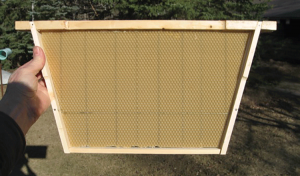 These are my experiences in year two including my successes and failures – the good, the bad and the ugly.
These are my experiences in year two including my successes and failures – the good, the bad and the ugly.
Although I strongly believed that a TBH is inferior to a regular hive such as a Langstroth, and I would not recommend it at all, I decided to have another year with it because I wanted to see if it was possible for a one-hive TBH hobbyist to raise queens without making the colony queenless – and I wanted to give it a fair trial as far as honey production was concerned.
As I have already said, manipulating and inspecting the frameless combs is very difficult because, contrary to popular myth, the bees always stick them to the sides, and secondly the combs break off the top bar at the slightest provocation. To overcome these two difficulties I decided to make a set of special rhomboid shaped frames that I wired with two horizontal wires and fitted with some old Dadant size foundation that was pre-Varroa, and thus pre all the Varroa chemicals. At first I only made about 14 frames but they were so successful that I set to and made another batch to give me a few spares.
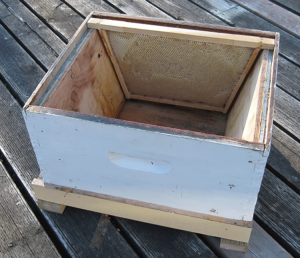 In Spring I had two colonies from the previous year in modified Langstroth brood boxes, one of which I sold and the other I did a transfer onto new combs, in this case transferring onto my new TBH frames in another modified Langstroth brood box.
In Spring I had two colonies from the previous year in modified Langstroth brood boxes, one of which I sold and the other I did a transfer onto new combs, in this case transferring onto my new TBH frames in another modified Langstroth brood box.
As soon as the queen was laying in the TBH frames I put a queen excluder between the two boxes. After three weeks all the brood had emerged in the combs below the excluder so I transferred all the TBH frames + bees to the TB hive itself. As Spring progressed towards Summer and the bees expanded, I kept adding new frames with foundation. They tended to put the honey at the back furthest from the entrance so I slipped the new combs between the honey and the brood as I didn’t think that the queen would cross three or four combs solid with honey. With about 15 combs occupied the bees didn’t seem to want to go horizontally any more and started plugging the brood area with honey. So I added a Langstroth queen excluder and super at the end above the brood. At the other end I covered the tops of the frames with a canvas cloth and an empty super to make both ends equal height for the roof to fit on.
Queen rearing. All was going well; the super was filling up so I decided to try raising some queens using my special method that does not require making the colony queenless. First I prepared a top bar with queen cups and then went through the brood until I found a frame with eggs and very young brood. After shaking/brushing off all the bees I closed up the brood area and replaced the excluder and super on top. Then I grafted the smallest larvae into my queen cups and returned the comb of brood together with the grafted queen cups behind three solid honey combs with one partial full honey frame at the end before the dummy board.
From what I said in the previous paragraph you will understand that the queen rearing was going on at the back, under the canvas cover cloth, so it was easy to check them without removing the super or disturbing the queen and brood at the front end under the super. After 48 hours I had a quick look. Eight of my eleven queen cells were being nicely drawn down so I envisioned plenty of new queens and proof that one could raise queens in a horizontal hive. However it was not to be . . . A couple of days before the new queens were due to emerge I was all ready to make up my nucs and insert the ripe queen cells, but when I went to check, there was the old queen destroying all the cells. Thus it goes to show that the queen will cross three solid combs of honey and a queen excluder is necessary.
Back in the workshop I made another vertical queen excluder from an old zinc one, re-enforced and riveted all around, that fitted tight against the sidewalls, bottom and top.
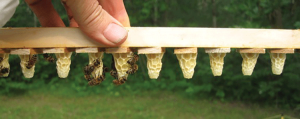 With the new queen excluder in front of four solid combs of honey, I grafted another batch of larvae into another set of queen cups and this time I got 100% acceptance: 11 out of 11. As previously, a couple of days before the virgins were due to emerge I made up three nucs with a frame of hatching brood, a shake of extra bees and a ripe queen cell. At the same time I put the old queen from the main colony with the comb she was on plus a frame of honey in a nuc box and gave the main colony a queen cell in a queen cell protector cage.
With the new queen excluder in front of four solid combs of honey, I grafted another batch of larvae into another set of queen cups and this time I got 100% acceptance: 11 out of 11. As previously, a couple of days before the virgins were due to emerge I made up three nucs with a frame of hatching brood, a shake of extra bees and a ripe queen cell. At the same time I put the old queen from the main colony with the comb she was on plus a frame of honey in a nuc box and gave the main colony a queen cell in a queen cell protector cage.
After three days I checked the nucs (not the main colony) to make sure the virgins had emerged, and yes they had. Then I waited for a week and checked for eggs. No eggs. Give them a few more days and check again. Yes, eggs in all three nucs. Here is where patience is required and my stupidity started! I didn’t have enough patience. I’ve been raising queens for years and years and should have known better. Now that I had three new queens (and likely a fourth in the main colony) I didn’t need the old queen as a reserve so I killed it and put the comb of brood that it was on into one of the nucs that was short of bees. I then turned another of the nucs about 30 degrees to pick up the flyers. Bad move, as both of my nice new queens were killed. After that bad experience I united through newspaper one of the now queenless nucs to the nuc with the last remaining newly mated queen. At least that one survived.
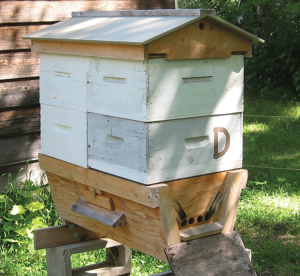 Since I hadn’t meddled with the main colony I thought they must be OK, but at 5 o’clock one hot evening they swarmed (!!), settling at the top of a very tall spindly tree and totally impossible to catch. But . . . there was quite a bit of activity around my bait hive and the next day a swarm went in. Whether this was the swarm up in the top of the tree or a second swarm, I’m not sure as I would have expected the main swarm to be a lot bigger than the one that went into the bait hive. The reason I had not checked the main hive was because it had two heavy deep Langstroth supers, both full, and with my bad back they were too heavy to lift. Fortunately a beekeeper friend came to visit and he kindly helped me with the supers and went through the brood with me. We found that my original queen cell in the protector cage appeared to have emerged as expected, but there were lots of emergency queen cells as well. I’ll never know exactly what happened but I would guess that the prime swarm was from the first emergency virgin to emerge. We opened one of the emergency queen cells to see how advanced they were and the virgin ran out, so because my friend was in a hurry we closed up and left them to sort themselves out. Another mistake – I should have removed all the other queen cells so they couldn’t send out a second swarm and I didn’t think of it until later, so I hoped for the best, in vain it seems. At least the swarm in the bait hive got its virgin mated and laying after a few days, but on Langstroth frames instead of my special TBH frames.
Since I hadn’t meddled with the main colony I thought they must be OK, but at 5 o’clock one hot evening they swarmed (!!), settling at the top of a very tall spindly tree and totally impossible to catch. But . . . there was quite a bit of activity around my bait hive and the next day a swarm went in. Whether this was the swarm up in the top of the tree or a second swarm, I’m not sure as I would have expected the main swarm to be a lot bigger than the one that went into the bait hive. The reason I had not checked the main hive was because it had two heavy deep Langstroth supers, both full, and with my bad back they were too heavy to lift. Fortunately a beekeeper friend came to visit and he kindly helped me with the supers and went through the brood with me. We found that my original queen cell in the protector cage appeared to have emerged as expected, but there were lots of emergency queen cells as well. I’ll never know exactly what happened but I would guess that the prime swarm was from the first emergency virgin to emerge. We opened one of the emergency queen cells to see how advanced they were and the virgin ran out, so because my friend was in a hurry we closed up and left them to sort themselves out. Another mistake – I should have removed all the other queen cells so they couldn’t send out a second swarm and I didn’t think of it until later, so I hoped for the best, in vain it seems. At least the swarm in the bait hive got its virgin mated and laying after a few days, but on Langstroth frames instead of my special TBH frames.
Conclusions. So at the end of all this what conclusions can be made:
- Most importantly to me, I have demonstrated that it is possible to raise queens at the back of a TBH without making the colony queenless.
- Although not a complete test, because I lost the prime swarm, it is possible to get a reasonable honey crop from a TBhive, but in this area supers are necessary.
- Patience, patience and more patience is required when manipulating colonies with newly mated virgins.
- And finally……. In my view the Top Bar Hive for the investment in time and money is totally unsuitable for keeping bees in the modern way because they are too difficult to manipulate. Swarm control is impractical and the loss of a swarm will usually mean the loss of the honey crop. They may be more suitable in Africa where they were originally developed as an alternative to the traditional log hives that local people could make without sophisticated tools or nicely planed boards of wood.
My advice to anyone thinking about getting a Top Bar Hive is, don’t. Similarly the Warre hive: don’t. If you want to have chemical free combs, spend your money on a foundation press and make your own foundation using your own cappings wax.
And you have probably been thinking that if I am going to have 21 odd shaped frames in an odd shaped hive it would be a lot easier to have 21 regular Langstroth frames in an elongated regular brood box, and you are right. That was my project for 2016.




